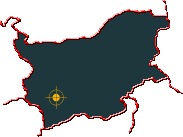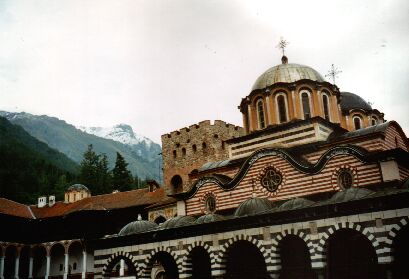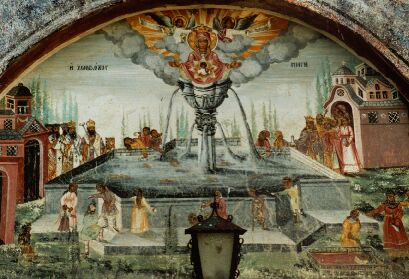|
|
|
|
|
|
 Name:
Рила (Rila). The monastery was founded by a monk named
Ivan Rilski, hence the present name. The same name was given to a small village at the foot of the
mountains as well as to the mountain range itself.
Name:
Рила (Rila). The monastery was founded by a monk named
Ivan Rilski, hence the present name. The same name was given to a small village at the foot of the
mountains as well as to the mountain range itself.
Location:
The worldwide famous monastery and the village with the same name are around 20 kilometres away from each other.
Both can be found some 120 km south of →Sofia in the middle of Rila Mountains.
Right behind the monastery, 2,729 metres high Malyovitsa is covered with snow for most time of the year.
The highest summit of Bulgaria, Mt. Musala, is only 20 km away to the east from the monastery.
From the village Rila, you only need to follow the river Rila upstream to get to the monastery, but it takes a
few hours to get there on foot.
History:
Рилски Манастир
(Rilski Manastir, Rila Monastery) has a long and interesting history: It was founded during the 10th century by
Holy Ivan Rilski (who can be seen on the 1 Leva bills), but the original monastery was a few kilometres away
from its present location. Already at that time, Rila was an important spiritual centre of Bulgaria. Due to the occupation by
the Byzantine Empire, the monastery was to be abandoned. During the Second Bulgarian Empire, in the 14th century, the
monastery was reactivated and therefore rebuilt at its present location. Now, a fortification system was added, but it wasn't of
much help during the next occupation by the Ottomans in the 15th century - the monastery was destroyed again. And reactivated
again in 1566. The monks were everything but isolated - there was a lively exchange with the monasteries of Athos (in Greece) and
even with clerics in Russia. During the 17th and 18th century, Rila was the centre of Bulgarian culture during the Ottoman rule.
Writers as well as scholars worked here. Among other things, they developed the Basics of modern Bulgarian language.
The importance of Rila as the spiritual heart of Bulgaria didn't change during the 19th and 20th century.
Getting there:
It's possible to go to Rila from →Sofia and back within one day - either by joining one of the
organized tours, which are offered everywhere in →Sofia, or by doing it on your own.
But doing it on your own is not really recommended if
you want to get back the same day (unless you have money to burn and hire a taxi). There are only two regular buses a day
from Sofia (Ovcha Kupel bus terminal) to the village of Rila. The ride takes about 2 hours. There are shuttle buses from the village
to the monastery, which takes another 30 minutes. Another option is to take the bus or train to Blagoevgrad and from there
another bus to Rila - the latter runs once in an hour.
|
|
|
|
|
|
|
As already mentioned above, the original monastery was built at another place. The monastery as it can be seen today
is an interesting mixture of several buildings from different centuries. To protect the inhabitants, the monastery is
surrounded by a tall outer wall, which only has one entrance. In the background of the picture below, a rather
plain tower can be seen. This is the so-called Chrelyo tower, which marks the oldest part of the
monastery. The upper floors of the tower house a small chapel, featuring some very old frescoes.

| |
Rila monastery and mostly snow-covered Rila mountains
|
Wide parts of the monastery were renewed during the 19th century - among them the
monk's cells and the meeting rooms. Unfortunately, little later a huge fire
destroyed most of it. However, the Ottomans allowed to rebuild the monastery. At that time, the
extraordinarely beautiful southern wing with its splendid façade and frescoes
was rebuilt as well.
The most important part of the monastery is - of course - the main church, called Catholicon,
which occupies the middle of the courtyard. The church was built from 1834 to 1837 in the neo-byzantine, typical Bulgarian
revival style and contains precious art treasures such as a large, gilded iconostasis and numerous colourful frescoes.

| |
Rila's frescoes alone make the place an unforgettable destination |
Talking about frescoes - most of the frescoes in Rila monastery were created between the 14th and 19th century, and so
the diversity is quite amazing. Most of the frescoes have been restored recently and are in an excellent condition.
Some of the frescoes were painted by the famous brothers
Dimiter and Sacharij Sograph. Only at the Catholicon itself, there are some 1200 frescoes, depicting
stories from the bible colourfully. Wide parts of the monastery are open to the public. The monastery houses, among other things,
three museums - occupying most of the 300 rooms.
There's no doubt that Rila monastery and its beautiful surroundings are a highlight of a visit to Bulgaria. Needless to say that thousands
of tourists visit the place every day, especially during the summer months, but in autumn or winter there are days, where you won't
have to share the atmosphere with coach parties. Rila monastery is a UNESCO world heritage site. If this monastery
impressed you, you might want to go ahead and visit →Bachkovo Monastery, which is smaller
but not less impressive.
.
|
|
|
|
|
|
|
Around 3 kilometres away from the monastery, Ivan Rilski's caves
mark the place where Rilski was supposed to live and work. Several marked trails lead to the Rila mountains, which
makes the monastery an ideal base for hiking and climbing tours. As already mentioned above, the highest mountains of
Bulgaria (actually of the entire Balkan area) can be found in the vicinity.
|
|
|
|
|
|
|
It's possible to stay overnight in the monastery for around € 10 per person, but capacity is limited and it's
recommend to make a reservation. In the surrounding mountains, so-called Hizha (mountain huts)
offer an interesting alternative when looking for a place to stay. It's also possible to make a day trip from →Sofia.
|
|
|
|
|
|
|
www.kolumbus.fi/boykor/rila.htm:
Very detailed site about Rila monastery in English.
www.foodnotbombs.net/rila.shtml
Some images offering a different view on Rila monastery.
Do you have or do you know a good website about Rila? Don't hesitate, let me know!
After checking it, I would love to add it to the link list.
Please note that commercial websites will be declined. For e-mail link see menu on the left.
|
|
| |